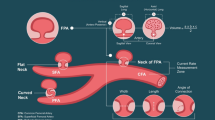Abstract
Pseudoaneurysms following femoral arterial catheterization are increasingly common and are related to factors such as catheter size, periprocedural anticoagulation, hypertension, and improper technique. Ultrasound-guided compression as a noninvasive technique for repair of these lesions was prospectively evaluated in 16 patients whose mean age was 61 years. Nine patients were on anticoagulants and six had hypertension. All patients presented with an enlarging groin hematoma, a pulsatile mass, and/or a bruit following femoral catheterization. Seventeen femoral artery pseudoaneurysms, including one with an associated arteriovenous fistula, were detected using color-flow Doppler imaging. Three pseudoaneurysms thrombosed spontaneously. The remaining 14 were managed with compressive therapy lasting from 20 to 100 minutes. No complications were encountered during the compressions and 10 false aneurysms (71%) responded completely (mean time to thrombosis of 38 minutes). Two lesions responded partially to compression and there were two failures, the latter associated with excessive anticoagulation in one patient and a well-established pseudoaneurysm in the second patient. Only one pseudoaneurysm (6%) in the series required surgical correction. Ultrasound-guided compression of acute pseudoaneurysms in the groin is a safe, inexpensive, and effective method of treatment.
Similar content being viewed by others
References
Skillman JJ, Kim D, Baim DS. Vascular complications of percutaneous femoral cardiac interventions. Arch Surg 1988;123:1207–1212.
Roberts SR, Main D, Pinkerton J. Surgical therapy of femoral artery pseudoaneurysm after angiography. Am J Surg 1987;154:676–680.
McMillan I, Murie JA. Vascular injury following cardiac catheterization. Br J Surg 1984;71:832–835.
Babu SC, Piccorelli GO, Shah PM, et al. Incidence and results of arterial complications among 16,350 patients undergoing cardiac catheterization. J Vasc Surg 1989;10:113–116.
Hessel SJ, Adams DF, Abrams HL. Complications of angiography. Radiology 1981;138:273–281.
Seidenberg B, Hurwitt ES. Retrograde femoral (Seldinger) aortography: Surgical complications in 26 cases. Ann Surg 1966;163:221–226.
Bourassa MG, Noble J. Complication rate of coronary arteriography: A review of 5250 cases studied by a percutaneous femoral technique. Circulation 1976;53:106–114.
Kresowik TF, Khoury MD, Miller BV, et al. A prospective study of the incidence and natural history of femoral vascular complications after percutaneous transluminal coronary angioplasty. J Vasc Surg 1991;13:328–336.
Messina LM, Brothers TE, Wakefield TW, et al. Clinical characteristics and surgical management of vascular complications in patients undergoing cardiac catheterization: Interventional versus diagnostic procedures. J Vasc Surg 1991;13: 593–600.
Dorfman GS, Cronan JJ. Postcatheterization femoral artery injuries: Is there a role for nonsurgical treatment? [editorial]. Radiology 1991;178:629–630.
Mills JL, Wiedeman JE, Robison JG, et al. Minimizing mortality and morbidity from iatrogenic arterial injuries: The need for early recognition and prompt repair. J Vasc Surg 1986;4:22–27.
Fellmeth BD, Roberts AC, Bookstein JJ, et al. Postangiographic femoral artery injuries: Nonsurgical repair with US-guided compression. Radiology 1991;178:671–675.
Fellmeth BD, Baron SB, Brown PR, et al. Repair of postcatheterization femoral pseudoaneurysms by color flow ultra-sound guided compression. Am Heart J 1992;123:547–551.
Fellmeth BD, Buckner NK, Ferreira JA, et al. Postcatheterization femoral artery injuries: Repair with color flow US guidance and C-clamp assistance. Radiology 1992;182:570–572.
Agrawal SK, Pinheiro L, Roubin GS, et al. Nonsurgical closure of femoral pseudoaneurysms complicating cardiac catheterization and percutaneous transluminal coronary angioplasty. J Am Coll Cardiol 1992;20:610–615.
Feld R, Patton GM, Carabasi A, et al. Treatment of iatrogenic femoral artery injuries with ultrasound-guided compression. J Vasc Surg 1992;16:832–840.
Sorrell KA, Feinberg RL, Wheeler JR, et al. Color-flow duplexdirected manual occlusion of femoral false aneurysms. J Vasc Surg 1993;17:571–577.
Abu-Yousef MM, Wiese JA, Shamma AR. The “to- and-fro” sign: Duplex Doppler evidence of femoral artery pseudoaneurysm. AJR 1988;150:632–634.
Mitchell DG, Needleman L, Bezzi M, et al. Femoral artery pseudoaneurysm: Diagnosis with conventional duplex and color Doppler US. Radiology 1987;165:687–690.
Helvie MA, Rubin JM, Silver TM, et al. The distinction between femoral artery pseudoaneurysms and other causes of groin masses: Value of duplex Doppler sonography. AJR 1988;150:1177–1180.
Sacks D, Robinson ML, Perlmutter GS. Femoral arterial injury following catheterization. J Ultrasound Med 1989;8:241–246.
Sheikh KH, Adams DB, McCann R, et al. Utility of Doppler color flow imaging for identification of femoral arterial complications of cardiac catheterization. Am Heart J 1989;117: 623–628.
Igidbashian VN, Mitchell DG, Middleton WD, et al. Iatrogenic femoral arteriovenous fistula: Diagnosis with color Doppler imaging. Radiology 1989;170:749–752.
Kotval PS, Khoury A, Shah PM, et al. Doppler sonographic demonstration of the progressive spontaneous thrombosis of pseudoaneurysms. J Ultrasound Med 1990;9:185–190.
Johns JP, Pupa LE Jr., Bailey SR. Spontaneous thrombosis of iatrogenic femoral artery pseudoaneurysms: Documentation with color Doppler and two-dimensional ultrasonography. J Vasc Surg 1991;14:24–29.
Paulson EK, Hertzberg BS, Paine SS, et al. Femoral artery pseudoaneurysms: Value of color Doppler sonography in predicting which ones will thrombose without treatment. AJR 1992;159:1077–1081.
Dol JA, Reekers JA, Kromhout JG. Rupture of pseudoaneurysm during attempted US-guided compression repair [letter]. Radiology 1992;185:284.
Schwend R, Torruella A, Kwan K, et al. The effect of anticoagulation on manual thrombosis of iatrogenic pseudoaneurysms. J Vasc Technol 1992;16:212.
Author information
Authors and Affiliations
Additional information
We thank Brenda Scott, Tammy Kovacs, Lisa Ungar, and Alison Grzywnowicz in the ultrasound department at Victoria Hospital for the time and enthusiasm they devoted to this project.
About this article
Cite this article
Moote, D.J., Hilborn, M.D., Harris, K.A. et al. Postarteriographic femoral pseudoaneurysms: Treatment with ultrasound-guided compression. Annals of Vascular Surgery 8, 325–331 (1994). https://doi.org/10.1007/BF02132992
Issue Date:
DOI: https://doi.org/10.1007/BF02132992




